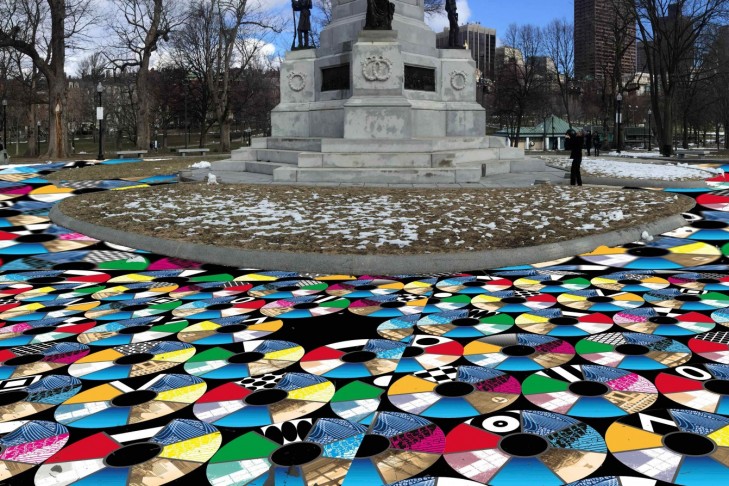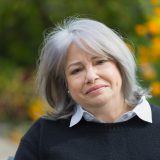Artist Julia Vogl is aiming to put the “public” back into “public art” with her latest project, “Pathways to Freedom.” The London-based, American-born artist has been in Boston for the last three weeks gathering data for the project, which will be installed on the Boston Common the last week of April. The installation is a collaboration between Vogl and the Jewish Arts Collaborative (JArts). Laura Conrad Mandel, executive director of JArts, told JewishBoston the partnership came out of a desire “to have a communal conversation and voice thoughts about important social and political issues.” Mandel said Vogl’s work was a natural fit and bringing her to Boston around Passover has allowed JArts “to educate the public more deeply about the universal themes of freedom and immigration.”
For the past three weeks, Vogl has been gathering information by holding “encounters” at a cart in locations throughout the Boston area, including City Hall, JCC Greater Boston, Mattapan, Dorchester and WBUR’s offices.
Each encounter is a conversation with a person rooted in four questions about freedom. Vogl then creates a customized pin, color-coded to how the individual answers each question. These “legacy components,” as Vogl calls the pins, evoke a seder plate. She told JewishBoston, “I want people to walk away with a reminder that they participated in this project, as well as see themselves as part of something bigger.” Her goal is to have 2,000 encounters.
The four questions Vogl asks are meant to echo the Four Questions the youngest child asks at the seder. “I studied the Haggadah extensively,” Vogl noted. “I wanted the questions I posed to feel different and accessible to all ages and backgrounds. It was important to me that a lot of the visuals of this project be rooted in Passover symbolism.”
The repetition imbedded in the Four Questions is key to Vogl’s methodology. “Mah Nishtanah is really one question that we ask four times,” she explained. “We have the youngest person ask it because youngsters are never sated with the first answer.” At the same time, Vogl is looking to deepen the answers she receives to a different question: How long have you been in the Boston area? “If you ask the same question four times you get different aspects of a person’s life,” she said. “You may measure that time in the number of jobs or addresses that person has had. It gives a much bigger picture of who someone is.”
Vogl, who will be holding encounters through April 8, asked that not all four questions she is asking participants be disclosed ahead of time. She’s looking for spontaneity. “I don’t want people to overthink their answers,” she said. However, I had her permission to share one question in which she asks, “If freedom were a food, what would it look like?” Among the choices was an eclectic buffet or a dish of ice cream. I picked the buffet, imagining my freedom rooted in the fact that I had so many good options from which to pick. Vogl said she perceived freedom as “that dish of ice cream because it is hard to hold onto. It could easily melt away. There is an urgency to enjoy it.”
The information Vogl collects during the encounters will be translated into a visual tapestry on the Boston Common; the data is paired with a digital version of each pin Vogl individually tailored for participants. The digital versions of the pins will comprise a large piece scheduled to be mounted at the base of the Soldiers and Sailors monument on the Common. “Your pin,” she said, “gets placed on a map of the site, which will get printed as a huge sticker for the 5,000-foot base. People will be able to match up their pins, as well as see what other people thought.”
Mandel described the final artistic product as “a community mosaic.” The piece is a “visual intervention,” Vogl added. “It makes someone see something differently that they are familiar with in ways that are really powerful. People who work in the area will have this kind of joyous break and have a different way of looking at the Common. It can also motivate the way they see the world in general.”
While Vogl and the team at JArts have been conceptualizing the project for almost two years, it will only be up for a week. Vogl said it’s important that Pathways to Freedom be an ephemeral experience. “In some ways the project is in the pins,” she said. “The event may come and go, but the pins stay around. People will keep wearing them and spark dialogue. Freedom is fluid; it’s not just one thing.”
Find more information about Pathways to Freedom encounters here.



